TOM FRANCIS
REGRETS THIS ALREADY
Hello! I'm Tom. I'm a game designer, writer, and programmer on Gunpoint, Heat Signature, and Tactical Breach Wizards. Here's some more info on all the games I've worked on, here are the videos I make on YouTube, and here are two short stories I wrote for the Machine of Death collections.
Theme
By me. Uses Adaptive Images by Matt Wilcox.
Search
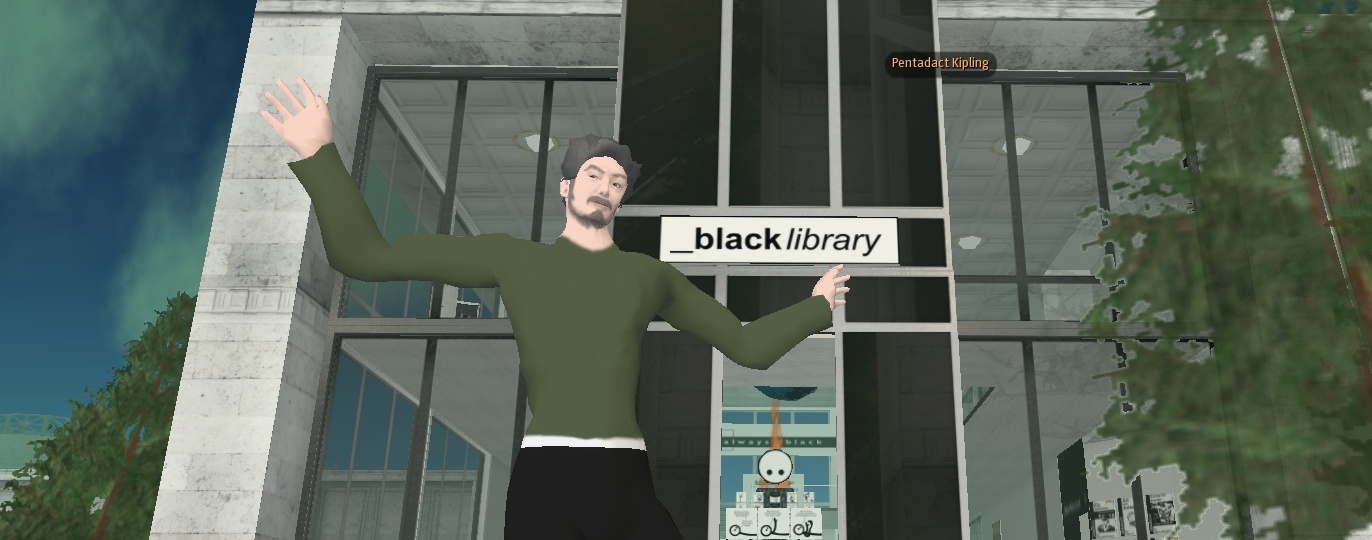
First Night, Second Life
Second Life is a Massively Multiplayer Online… Place. There’s no goal, so it’s not a game, but it lets you create things – potentially of enormous complexity. People make games within it. Somewhere, I’m told, there’s a hangar in which people are still playing a World War II MMOG they recreated in SL after the real one got scrapped. A basic Second Life account is free, and with that you get a few hundred virtual dollars to buy and make stuff – on top of which, a lot of groovy players give away copies of the stuff they’ve made for free.
Snow Crash gets referenced a lot when talking about Second Life. Snow Crash was a sci-fi novel in which the internet was a single coherent 3D world, and everyone had a single character to represent them in that world. Sites became places that you travelled to, and you’d see the other people there when you visited it. Second Life is the closest we’ve come to such a thing, because the things in it are player-created places and services, rather than a simulation of some fantasy world designed by the developers. The comparison is obvious and complimentary enough for the developers to include ‘Protagonist’ as one of the surnames you can select for your character, a nod to Snow Crash’s legendary Hiro Protagonist.
The Black Library is a building in Second Life created (with help) by Always Black, a games writer responsible for some great articles that have appeared in our magazine. I mentioned his series of ‘_black’-prefixed sites and services a few posts back, because it was one of them that inspired me to sign up for the Novel Writing Month thing. The Black Library has articles by AB or submitted to his site, and also some more adventurous exhibits that use the nature of the world in which it exists. Another writer publishing stuff within Second Life is Cory Doctorow, one of the Boing Boing guys, who released a sci-fi novel in-game.
Lastly, it may also be useful to know that the film The Life Aquatic features a great scene where they’re in a submarine deep underwater, a Sigur Rós track is playing, and the enormous Tiger Shark they’ve been searching for all along passes serenely and prettily over their sub.
Right, I apologise for the amount of background knowledge necessary to understand this story, and will attempt to call upon it all in the next sentence to show just how necessary it was. I was downstairs at the Black Library. Okay, not to worry, the rest will come in later.
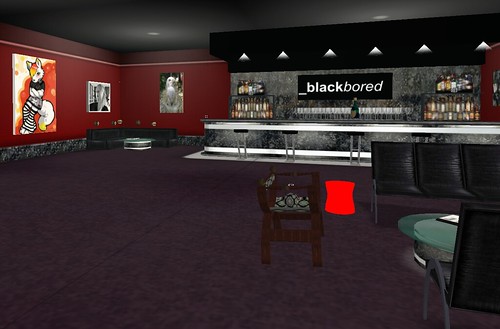
The downstairs bit is a rather classy bar, and it’s named after the forum part of AB’s site. I was sitting on a pleather sofa looking at some blue text. It said I was 11m away, the guys I was just talking to upstairs were a bit further than that, and between the two was Wandering Yaffle. Neat, a proximity detector! Wandering Yaffle came down the stairs, as if to demonstrate that it worked. He is, I knew, Always Black – or less exotically Ian. There’s a hologram of him in the lobby to greet visitors. He sat down in a chair that automatically puts you into a relaxed pose, which made me look incredibly tense.
I am hugely impressed by the Black Library, especially the bar of the forum, and I said so. It’s a sleek, sparse, attractive modern building, more like a trendy art gallery than a library. This fits well with the fact that it isn’t primarily a library – the articles that lie on the shelves upstairs, each with their own stylish 1-bit cover, aren’t positioned or seen as the main exhibit. They’re essentially just links to the articles online, and Ian realises that makes little use of the potential of this place. He’s been setting up some more progressive attractions around the building, and has already incorporated an interesting object not of his own design.
Wandering Yaffle: Have you seen the Infonet?
Pentadact Kipling: I think I sat on it earlier, yes.
Wandering Yaffle: Did you try clicking anything?
Pentadact Kipling: Yeah, but I couldn’t see what it was doing with my legs in the way.
He took me up to show it to me properly. It’s a sleek chrome laptop computer sitting on a desk in the corner of the lobby, and it shows a series of options like ‘log in’ on the main screen. When you do, you get access to Second Life news (both official and from the unofficial Second Life Herald), useful archives like little scripts you can use on the stuff you create to change the way they work, and tips for cool places to go. It’s cool. It’s a bit like the info terminals in games like City Of Heroes.
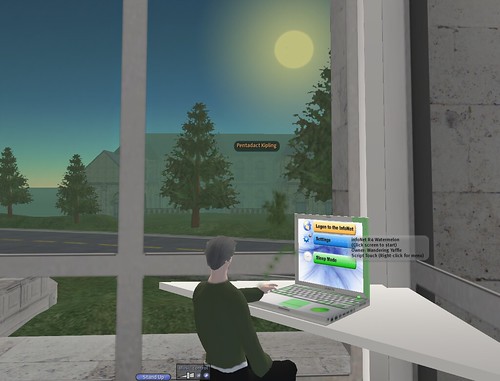
Actually, it turns out it isn’t. Second Life doesn’t have info terminals like City Of Heroes. This object was made by a player called Squagmire Stravinsky. The screen is a custom texture, and when you ‘touch’ a part of it, the script she wrote detects which part, works out which button you were pointing at, and retrieves the appropriate new texture to replace the old one.
Wandering Yaffle: I mean, there’s emergent gameplay, and then there’s…
Pentadact Kipling: Making an internet?
Wandering Yaffle: Making an internet. It gets the info from a server farm within Second Life.
Pentadact Kipling: Wow. So is the information actually stored there, or is it just a technical requirement?
Wandering Yaffle: Do you want to go there?
If this were an adventure game, my dialogue options would have been:
- YES.
- Do I!
- Duh.
I chose one at random, and we teleported.
It’s hard to believe that the places in Second Life are made by players. The Black Library is amazing enough, but in some areas it seems every building is a masterpiece of design. Where are the rubbish houses? Why aren’t these just white cubes with badly drawn windows painted on, like the dregs of the mapping community for other games? Squagmire Stravinsky’s central server complex is a spacious office with glass walls and hardwood floors, dotted with glowing blue signs, and even colourful posters for Second Life educational programmes.
I love that this place exists, I love that it looks like this, and I love that I can go here. Most of all, though, I love the hovering blue head telling me that it’s authorised personnel only beyond this point, because we’re at the door to the server room itself.
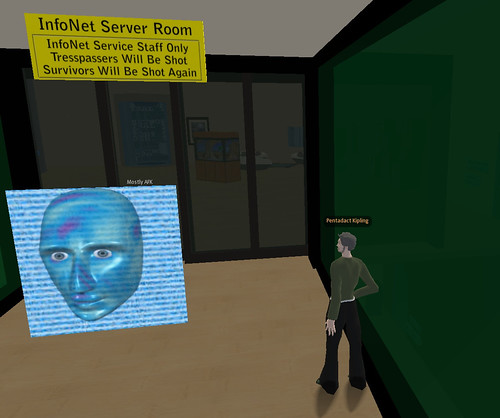
Wandering Yaffle: Okay, I’ve never done this before, so bear with me. If Squag’s security systems hammer me, tell my wife I always loved her.
Pentadact Kipling: You know, I’ve always wanted to be told this by a floating blue head.
Wandering Yaffle: Now, where did I put that walk-through-walls thingy?
Pentadact Kipling: Wait, what?
After a few moments’ fumbling, he stepped through the locked door. Then he stepped back, handed me an object called Phase Shield and told me to put it on. After equipping, you go into chat and type /1 phase on. I tried it, and walked forwards.
Pentadact Kipling: Whoa!
Pentadact Kipling: I’m not that familiar with this world, but something about that felt immediately wrong.
We were in a kind of private lounge – sixties-style curved beige benches, slot machines and an aquarium. To the right, another locked door labelled Squagmire Stravinsky, Owner, CEO. We stepped through.
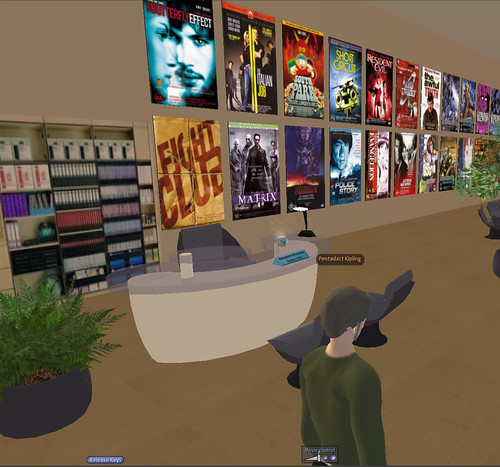
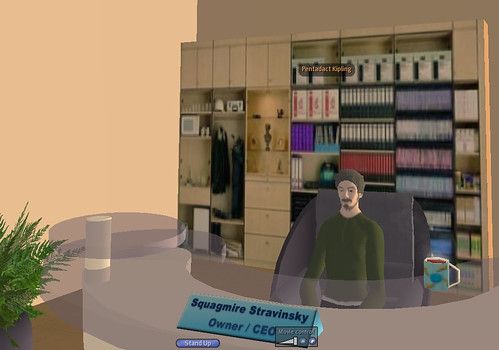
After sitting in her chair with a steaming mug of coffee, admiring her movie posters and wandering around the office, I was about to leave when I caught sight of a nametag floating past the glass door on the other side. Shit.
Pentadact Kipling: There’s someone in the corridor.
Wandering Yaffle: Don’t worry, Squag’s cool.
Pentadact Kipling: This didn’t look like Squag, it looked like a tiny waddling robot called Jackal Ennui.
We stepped out. In the corridor, going about its business, was a tiny waddling robot called Jackal Ennui. It stopped and looked at us.
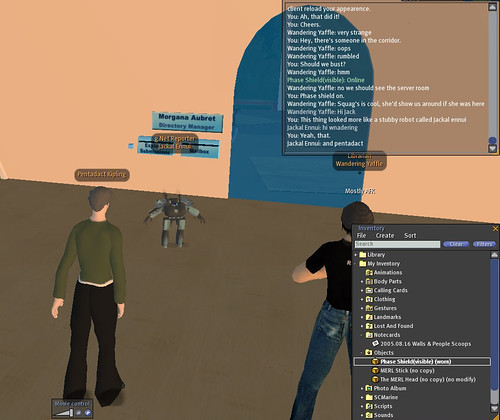
It wasn’t a long pause, but one of the strangest in my life.
Tiny Waddling Robot Called Jackal Ennui: hey guys
Wandering Yaffle: Hi Jack.
It turns out the tiny waddling robot called Jackal Ennui is a reporter for g.Net, Squagmire’s media company. He was perfectly personable, even if not, technically, a person.
Wandering Yaffle: Is it okay if we have a look at the server room?
Tiny Waddling Robot Called Jackal Ennui: i just started here so i have no idea what’s okay
Tiny Waddling Robot Called Jackal Ennui: have fun
He waddled off, and we stepped through the final locked door, into the inner sanctum.
Pentadact Kipling: Holy shit.
A suspended walkway led out to a single console, overlooking bank after bank of server machines on the floor below. The view was dominated, though, by a screen of statistics that took up the entire far wall of the hall, updated in real time as traffic and server status changes. Rather brilliantly, it turns out that the console overlooking this is just a regular Infonet laptop, so presumably Squagmire stands there and test things while watching the behind the scenes working on the giant screen behind it.
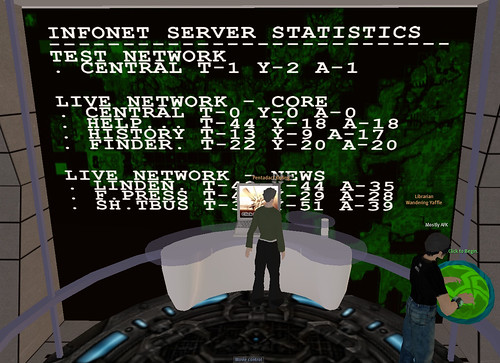

A stroll around the server room floor, a forest of monolithic machines, turned up a more puzzling part of what goes on in this room. It appeared to be a bungalow. Inside, there was a single chair lit moodily by two lamps, then empty space before a small marble table surrounded by floral chairs. I sat down in the spooky seat, and Wandering Yaffle wandered in.
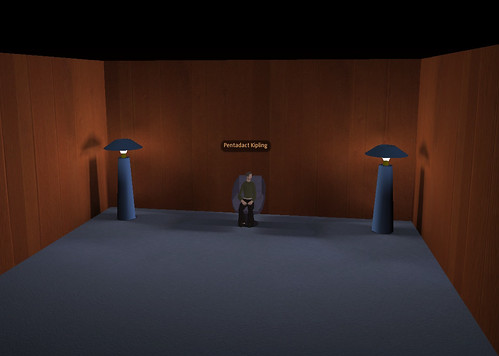
Wandering Yaffle: What the hell?
Pentadact Kipling: I automatically go for the most unusual seat I can find.
Wandering Yaffle: No, I mean, what is this place?
Pentadact Kipling: Maybe a super-private meeting room? Whoever usually sits here must have a sinister job.
Wandering Yaffle: It looks domestic, though.
He was right, it did. We sat down at the domestic looking table, a small lamp between us, and talked for a bit. A phrase that comes up almost as often as Snow Crash or ‘metaverse’ when talking about Second Life is ‘glorified chat room’. I think the ability to create anything you can imagine probably counts for a bit more than glory, but it’s fair to say that this is how a lot of people actually use it. The glorification is great, though – nothing fills an awkward lapse in conversation like suddenly donning a giant white spherical head and setting yourself on fire. But even more glorious, to me, is the wandering. Ian was telling me that Squags, like many before her, is seriously looking at ditching her real job and making Second Life’s internet her primary source of income – it’s free to use, but she makes money selling the laptop terminals to people like Ian looking to enhance their virtual space. It’s an interesting enough conversation in any context, but that we were talking about it in floral chairs in a mysterious bungalow in the main server room of that very venture made it extraordinary.
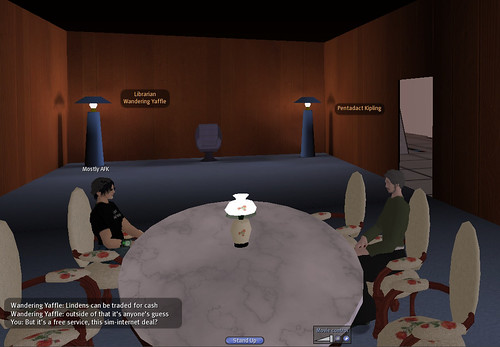
Wandering Yaffle: I’ve got it.
Wandering Yaffle: I know what this place is.
Wandering Yaffle: Shadows.
Buh?
Wandering Yaffle: She’s practising her shadows.
I’d noticed the room was moodily lit when I walked in, but what I hadn’t realised was that the ‘lit’ part was more remarkable than the ‘moody’. Second Life doesn’t really have lighting – sure, things are visible in the day and darker at night, but everything is uniform, there aren’t normally any true light sources or shadows. As with virtually everything, you have to make them yourself. Squags, it seems, was getting pretty good.
Later on, Walker Spaight joined us in these secret backrooms of g.Net. This was my first night in Second Life, and I’m embarrassed to admit that I knew the man only as Mark Wallace, yet another great games writer with a great blog – one whose 19th most followed link is to this very site, I have just accidentally discovered. It turns out he’s actually something of a celebrity in Second Life, being the Editorial Director of The Second Life Herald – which I think I’m right in saying is the most popular Second Life journal out there.
We’d slipped into another locked office belonging to someone called Venya Salome, and were sat on the nice sofas, talking about the State Of Play conference (at which Walker spoke, on a panel about games writing, and which is available to watch online as a webcast. Walker’s appearence is in the first video on that page). Some extraordinary ideas come up in the conference, and it’s so forward thinking that when you finish watching it, you have to remind yourself that the humdrum World Of Warcraft is the prevailent MMOG in reality, and these notions have yet to catch on outside of Second Life’s tiny yet extraordinarily rich community.
Venya Salome walked in. She was a tall, smartly dressed woman with silvery hair, the words g.Net Admin above her name, and black fingerless gloves. In another of the evening’s now characteristic awkward pauses, I reflected that she looked awfully serious for a game character, and that she was probably wondering what three games writers were doing in her office in the middle of the night.
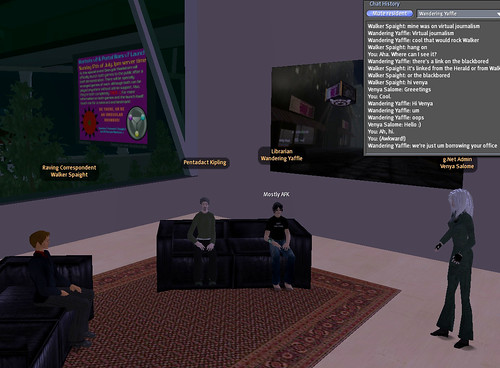
Venya Salome: Hello.
Pentadact Kipling: Awkward!
Wandering Yaffle: Hi, we’re just, uh, borrowing your office.
Feeling pretty bad about that, we left. I think the others just teleported out, but I didn’t see because for my part, I activated my phase shield and threw myself through the window.
Okay, so ultimately I didn’t get around to the part where that Life Aquatic scene becomes relevant, but I promise you, that snippet of information will serve you well some day.
More Diaries